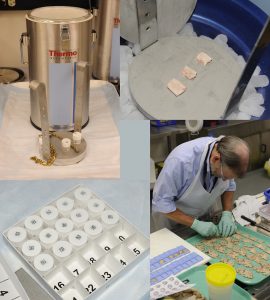Guest Post
The following is a guest post by Jeffrey T. Joseph, MD, PhD, Neuropathologist and Eric E. Smith, MD, MPH, Neurologist.

Because the human brain is unique with respect to the function, structure, and loss of its neurons, what we can learn through animal models about neurodegenerative diseases – such as vascular cognitive impairment and Alzheimer’s disease – is limited. Even though scientists have been studying neurodegenerative diseases for over 30 years, dementia is still diagnosed in the clinic. Physicians assess patients for telltale symptoms and behaviors, and offer probable diagnoses. Of course, this always leaves some degree of uncertainty about the cause of dementia.
Definitively diagnosing dementia and identifying its cause(s) can only occur after death. Hence, autopsies and brain donations that enable scientists to view tissues under a microscope after death are critical to advancing research in prevention, treatment, and quality of life for the 564,000+ Canadians living with dementia.
Fostering this, the Canadian Consortium on Neurodegeneration in Aging has five ‘brain banks’ across Canada, which are coordinated by Dr. Ian Mackenzie. These centers receive donations and provide scientists with tissue samples that give them direct access to the cells, genes, and proteins of the human brain. To access tissue, a researcher needs to have institutional review board-approval for research using human material.
In 2014 – thanks to funding we received from two private grants – we started a brain bank in Calgary. At first, we only collected donations from people who had dementia, but at the request of researchers, we have since expanded our bank to include tissues from people who had movement disorders, had multiple sclerosis, or aged “normally”. We are currently accepting donations from patients with dementia, a movement disorder, multiple sclerosis, and individuals who are aging without neurologic disease.
To make these tissues more useful to other scientists, we’ve characterized them by screening for Alzheimer’s disease, synucleinopathies, other tauopathies, frontotemporal dementias, and vascular disease, and have stained their proteins, including beta-amyloid, tau, alpha-synuclein, and TDP-43.
The types of preservation we have available include small samples frozen in liquid nitrogen vapour from specific anatomic sites (e.g. hippocampus, Brodmann area 9) as well as formalin-fixed, paraffin embedded samples, and formalin-fixed tissues. We store the frozen tissue in 2 cm barcoded cryovials at -80C. We can also provide blank slides from the primary autopsy blocks. For researchers who live near Calgary, we can provide fresh tissue.
If necessary – to better meet the needs of a specific research question – we can modify how samples are prepared and stored. We currently have tissues from about 80 brains – including 14 with advanced-stage Alzheimer’s disease, 11 with Lewy body disease, and 5 with progressive supranuclear palsy, in addition to 25 “normal” brains. Going forward, we anticipate banking tissue from patients with inflammatory neurodegenerative diseases, such as multiple sclerosis.
For additional information, please contact: Jeffrey T. Joseph MD PhD (jtjoseph@ucalgary.ca) or the University of Calgary Brain Bank (ucbb@ucalgary.ca).
The views and opinions expressed in this guest blog are those of the authors (individual CCNA scientists) and do not necessarily reflect the views of the Canadian Consortium on Neurodegeneration in Aging and its partner organizations.

